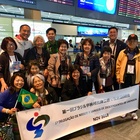According to the "Uken Village Journal: Natural History" published in November 2017, the first immigrants to Brazil were 13 families and 54 people from Uken Village on Amami Oshima Island in Kagoshima Prefecture, who traveled to Brazil on the Sanuki Maru from Nagasaki Port in September 1918. After that, 81 families and 491 people went to Brazil before and after the war, making Uken Village the "Brazilian immigrant village" that produced the most immigrants to Brazil in Amami.
Shimada Shizue, originally from Uken Village, was born in 1926. She moved to Brazil at the age of 31. As she says of that time, "I was the oldest," many of the women who moved from Amami to Brazil as "wives" were in their early 20s. After attending high school until her second year in Amami, Shizue moved to Tokyo to help her aunt give birth. She says of that time, "I went (to Tokyo) willingly, even though I didn't help my parents."
After moving to Tokyo and helping with the birth, she looked for work there. She wanted to be a bus girl, but her uncle told her "you can't speak the (island) language," so she worked at a spinning factory and learned the language. After two years, she got used to city life and finally became a bus girl. However, after just a year, the war started. The air raids were so bad that she couldn't concentrate on work, so she returned to Amami with her aunt and her children. Even after returning to Amami, there was no work she could do. Her father had already passed away, and her life became increasingly impoverished.
Her relatives told her to get married because there were no jobs, so she married a man much older than her. She didn't want to get married, but she "had no choice" and agreed. By the end of the war, they were blessed with four children. One day, her husband heard about a call for immigrants to Brazil in Naze. He said "nice things" to her, and she immediately decided to go to Brazil. In 1958, she traveled to Brazil with her husband, their five children, and her younger brother's family.

After arriving in Brazil, he started raising silkworms. He had heard only good things about immigrants, but the reality was different. Even after coming to Brazil, he continued to live a life where he could barely afford to eat. Like other immigrants, he changed jobs frequently in search of a "better life." His children grew up and he got married, and his life settled down. He helped out at a fishing company started by his eldest daughter's husband. When he reached retirement age, he felt like "I want to do something other than work," so he learned Japanese dance. After coming to Brazil from Amami, he finally had time to learn dancing and singing.
As her dancing improved, she began to teach others the dances she had learned. She continued to teach dance at the "Amami Hall," which was built by people from Amami living in Brazil. "I worked, worked, worked until I was 60. I didn't have time to dance or sing. So I can't do any shimauta or anything," she said, humming a shimauta song in the middle of her story.
Whenever Shizue-san held a gathering for people from Amami, they would perform the dance that they had all practiced together. When I first met Shizue-san in September 2014, she was no longer the dance "teacher," but everyone was still practicing using Shizue-san's dance as a model.
Shizue passed away in May 2015. On the day I met her for the first time, her second daughter told me, "You came (to Brazil) too late." She said that she should have listened to the stories of immigrants to Brazil when those who knew about their past were still in good health. She said that the story of immigrants is a race against time.
*This article is reprinted from the Nankai Nichinichi Shimbun (May 3, 2018).
© 2018 Kato Saori







